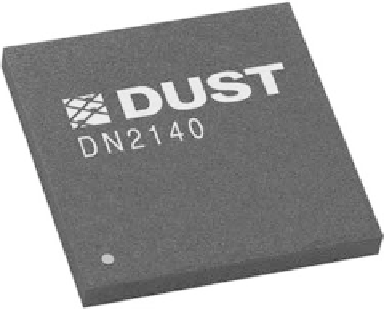Image Processing Reference
In-Depth Information
FIGURE .
DUST Networks SmartMesh MoC solution. (From DUST Networks, Inc., Media Kit—Product
Images. http://www.dustnetworks.com, . With permission.)
important decision we must make; we must select a proprietary solution that will provide/enable an
easy migration to WirelessHART.
In the end, the decision fell on a solution offered by DUST Inc. Networks [] called SmartMesh-
XD. It is a System-on-Chip (SoC) WSN solution called Mote-on-Chip (MoC), see Figure .. The
SmartMesh-XD MoC (DN/) is a “black box” solution, which hides all details related to the
wireless communication from the rest of the application.
DUST Networks will also provide a WirelessHART-based solution (SmartMesh IA-), which
uses identical hardware to the SmartMesh-XD MoC (including the interface), thus only requiring
a firmware upgrade in order to become WirelessHART compliant. This will allow for a smooth
transition to WirelessHART.
SmartMesh-XD is IEEE .. standards compliant and operates in the MHz and . GHz
ISM bands. It is a robust WSN technology that combines low-power radio technology with the
Time Synchronized Mesh Protocol (TSMP).
∗
TSMP, which was also the basis for the WirelessHART
standard, provides features such as time division multiple access (TDMA), frequency hopping, and
redundant paths (mesh), which make it suitable for the harsh operating environment of the applica-
tion. he SmartMesh-XD communication uses a concept called a network frame. he network frame
is a fixed length, cyclically repeating, sequence of time slots (TDMA), in which all nodes have been
assigned dedicated slots for message transmission and reception.
In the following sections, we highlight the impact of the decision to use SmartMesh-XD on the
design of the application, as well as implications for future migration to WirelessHART.
27.5 Communication Standards
The advent of WSNs brings many new and exciting technologies into the world of industrial automa-
tion. here are currently a number of initiatives underway for standardizing WSN for industrial use.
General trend on the market is consolidation of suppliers and migration toward standards, most
noticeably the release of WirelessHART and the development of ISA.a. Additionally, a major
automation network organization, PNO, has decided to use WirelessHART as a base for its wireless
process automation solution.
∗
TSMP is a proprietary WSN protocol developed by DUST Networks.










